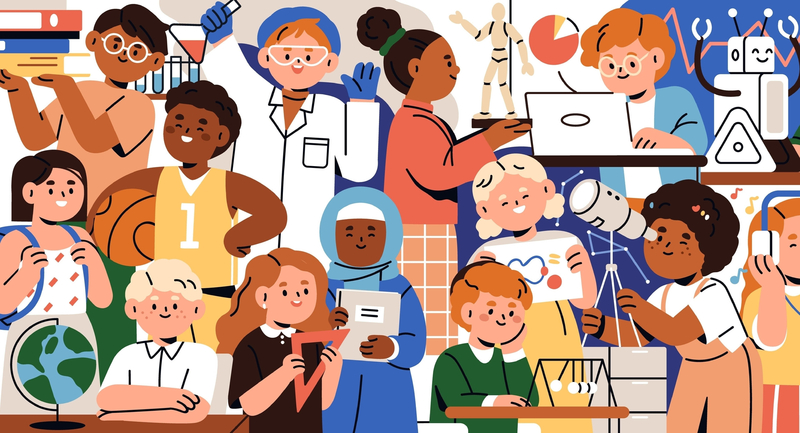Why can patients with certain types of brain damage have preserved cognitive abilities or intelligence as measured by IQ, yet be totally unable to manage their lives on a day-to-day basis? In the groundbreaking 2007 article "We Feel, Therefore We Learn," neuroscientists Mary Helen Immordino-Yang and Antonio Damasio synthesized 20 years of research led by Damasio and others in hospitals throughout the United States and Europe. Although these brain-damaged patients could perform well on laboratory tests of intelligence, they were unable to apply intelligent decision making to their own lives because they could not adequately incorporate emotion into their thinking. Emotions, Immordino-Yang and Damasio claimed, guide not only our motivation to learn, but also our moment-to-moment problem solving and decision making.
In her book Emotions, Learning, and the Brain (Norton, 2015), Immordino-Yang and colleagues expand on this theory and its implications for education. Rather than messy toddlers running amok in a china shop and threatening delicate cognitive glassware, Immordino-Yang argues, emotions are like the shelves that give cognitive glassware support. A former middle school science teacher and current University of Southern California professor of education, psychology, and neuroscience, Mary Helen Immordino-Yang talked with ASCD about the unbreakable bond between emotions and learning and what it means for schools.
You call emotions "the rudder that steers thinking." What do you mean by that?
Experts traditionally thought, based on Descartes and other western philosophical traditions, that high-level cognition is purely rational and that emotion comes along and messes it up. What we're finding is that's not really the case. Instead, cognition happens because of emotion. There's really no such thing as a thought that doesn't have an emotion attached to it or that doesn't have an emotion that follows it. When we take in the world around us, we have an emotional reaction to that appraisal. That emotional reaction changes the way we think in the next moment and cumulatively, over time.
Emotions are like the rudder that steers the ship because they push cognition into various modes. This means that you're more likely to think of things in particular ways, depending on the emotion you're having. All thinking is inherently emotional and cognitive, all at once. It's literally neurobiologically impossible to remember or think deeply about anything that you haven't felt emotion about. It just doesn't happen because it would be a waste of the brain's resources to think a lot about stuff that doesn't matter.
Can you give an example of how this plays out in the classroom?
Emotions drive not just our desire to solve a problem, but also the access to the memory that allows us to make sense of that problem. (Memory and emotion are intertwined in the brain.) For example, if you're solving a math problem and you think, Oh yeah, I recognize this; that's a quadratic equation. That little moment of, I know this! (or alternately I don't; am I on the right track?), that's emotion steering the way you access your memory. Recognizing that a skill (like solving a math problem) is relevant in a particular context is an emotional recognition. We need these subtle emotional intuitions for minute-by-minute problem solving, and therefore, they become a dimension of the skill itself. As teachers, we can help students become aware of how emotions steer thinking, and help them develop well-tuned academic intuitions.
Is there a danger in discounting the significance of emotions in our learning processes?
The reality, psychologically and neurobiologically, is that emotions are the thing that is causing us to think. If students and teachers are conscious, then they are experiencing things in an emotionally valenced way. That's the nature of being alive.
If teachers are not attending to the inherent role of emotions in thinking, then the emotions that are being recruited in the classroom may not be facilitating the kind of deep thinking you want. The key is to set up the class so that the students have conducive emotions about the actual ideas that you are working on. Emotions that aren't about those ideas are going to detract from the cognition because they're irrelevant. These emotions might be relevant to something else like, "I want to get out of here," or "I'm afraid to fail," or "It feels great to get straight As." They steer a student's mind into a place that isn't relevant to thinking about math or whatever your students are meant to be learning.
You note that stress and external distractions can set students' emotional rudders off course, and that means students may not learn academic content or learn it in very superficial ways (to pass a test, for example). What can educators do about this?
As teachers, we need to support the emotions that are an inherent part of the disciplinary thinking itself, like interest, the curiosity that drives us to continue working on something, and the little jolt of satisfaction that we get when we actually understand or achieve something. Educators need to find ways for students to be emotionally engaged with the ideas and skills they are exploring, and to downplay the external stuff like grades, fear, embarrassment, and stereotype threat. We need to support students in becoming intrinsically emotionally engaged with the content they're learning.
How can teachers create space for these productive emotional connections to academic content?
The way you make this happen in the classroom has to be context-specific. It depends on who your learners are, what situation they're in, and what they bring to the learning environment. You start by asking, Who are my learners? What have they lived? What matters to them? What ways of thinking, expressing, and engaging do they bring to the classroom that I could leverage to help them connect to this content?
Knowledge of your learners and their contexts then informs how you orchestrate opportunities for project-based learning, active reflection, debate, and Socratic dialogue. Simple reflection strategies like Project Zero's "I used to think … Now I think … " help kids become more aware of their own knowledge structures and how to explicitly rework their beliefs.
Kids need opportunities to teach each other what they know and to learn by vicariously observing skills in practice and trying them out for themselves. Rather than just reporting on things that are already known, teachers can orchestrate projects that allow students to test an idea and build their own experience with the content.
Taking on messy, real-world problems (like lead in Flint's drinking water) in multidimensional ways makes learning real and emotionally connected for students. It models the experience of solving problems that matter. So for example, in chemistry lab, you could do experiments on lead that are very abstract but the students will still be motivated because they know this knowledge gives them access to solving a bigger problem they care about. Think about how you can expand the range of problems that students recognize as relevant to their lives. It's not just about learning Shakespeare through rap because the kids like rap. That's very superficial relevance. The Flint lead water crisis is really about chemical processes and their ethical implications. The chemistry relates to a broader set of issues that matters whether or not you live in Flint. Helping kids see that is what gets them emotionally and cognitively engaged.
Instead of a prescription for education practices, you say your work on the connection between emotions and learning can be a launchpad for educators' discussions. Can you imagine some of the big questions those discussions might center on?
For one, What does real learning look like? My son is 12 and lucky enough to attend Ad Astra, Elon Musk's microschool at the SpaceX headquarters in Hawthorne, California. In classes like Ethics and Synthesis, students engage in solving deep, complex, integrative problems for over eight weeks at a time. Students are constantly wrestling with questions like, Why does this problem matter? What are the implications for the broader world? What do I understand and not understand about this problem? How can I recruit my various academic skills to answer these questions? What's left to know—either by me or the world?
Embedding skills in a problem and learning them along the way—that's what real learning looks like. Real learning isn't regurgitating back what somebody told you. We need to be teaching kids to engage with learning in a way that is deliberative and reflective, not just responsive.
Two, How do school structures support or impede this vision of real learning? At Ad Astra, there are no grade levels or course grades, but it took me half a year to notice it. The mixed nature of [my son's] classes meant assessments included both content he knew and stuff he'd never seen before. I think this helps kids become comfortable with the uncertainty of not knowing and get scrappy about developing intuitions for how to solve problems they may not have seen before. Creating structures that support those habits of mind is a big shift from the norm in most schools where if students do well on a test, they get 100 percent. It's impossible to get 100 percent on one of my son's tests; it's just not a goal. The goal is to engage with interesting problems and figure out what you can along the way. Students get scores, but they're constantly going back and reworking assignments. Testing is not the end of learning—it's the starting point telling you what you could learn next. So I'd think about how our schools are set up to teach kids that learning is a process with no end point.
We've talked about how affective neuroscience can provide new insights into how students learn and how that changes the classroom. What about teacher development?
What this really speaks to is the need for teachers to build a deep, multifaceted, dynamic understanding and appreciation of the human development they're promoting. "Learning outcomes" are only a small building block of what you're actually trying to achieve in school. When you redefine learning so that it is about the development of a person, not just compliance with a set of academic standards, it totally changes what kinds of training and support teachers need throughout their career. Teachers need opportunities to reflect on how to design lessons and orchestrate experiences that promote kids' personal development, not just the acquisition of skills, ideas, and facts. You know exactly what this means when you look at a great preschool or elementary school. We need to get that kind of training and thinking about learning throughout education.
The problem is twofold: first, getting all teachers to think about learning in service of developing the whole person, and second, figuring out what this type of learning looks like at the adolescent level. Currently, our country thinks content knowledge and classroom management skills are what you need to teach adolescents. If you've got those two things, you're a perfectly good 10th grade chemistry teacher. There's no expectation that high school teachers have expertise in adolescent development. But what are teachers trying to support in terms of a teen's personal capacity to engage thoughtfully with the world? Just having the skills because somebody gives them to you is not enough. That doesn't prepare our students to be adults and citizens.
As your research shows, students come to the classroom with an emotional relationship to learning, for better or worse. What would you say to educators working with students who seem emotionally detached from learning?
Recognize that emotions are cognitive processes, and that cognitive processes that lead to learning are emotional. We think in emotional-cognitive patterns that are acquired and become habits. The way you help a student change these patterns is by creating opportunities for them to relive or re-experience the classroom or disciplinary thinking in a way that teaches them how to have emotions that are conducive to deep thinking.
Teachers have to expressly help students become aware of these patterns and to rework them. You also have to give students ample, supported opportunities to learn how to enhance disciplinary thinking in a more emotionally conducive way. That means modeling thinking for students and orchestrating clever classroom opportunities that are likely to help them discover for themselves how to feel about the content they are learning. And it means when teachers hit trauma or some pervasive emotional pattern that's undermining the learning process, they have to stop and deal with that in a way that is developmentally appropriate and suits the individual child.
Teaching is a nuanced, developmental, and artistic endeavor. It's an extremely difficult thing to do well because what you're really doing is not giving students stuff; you're orchestrating a world where they are likely to discover things for themselves. When you think of teaching this way, students will begin to rehearse healthy patterns of interest, curiosity, and problem solving that will serve them well no matter what work they go into.
Editor's note: This interview has been edited for length and clarity.








